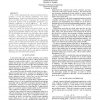Free Online Productivity Tools
i2Speak
i2Symbol
i2OCR
iTex2Img
iWeb2Print
iWeb2Shot
i2Type
iPdf2Split
iPdf2Merge
i2Bopomofo
i2Arabic
i2Style
i2Image
i2PDF
iLatex2Rtf
Sci2ools
ICRA
1993
IEEE
1993
IEEE
Mechanical Computation for Passive Force Control
Force control implemented by a passive mechanical device (perhaps a wrist) has inherent advantages over active implementations. A passive mechanical device can regain some of the versatility of its active counterpart if it incorporates mechanical elements with programmable parameters, e.g. damping coefficients or spring stiffnesses. We wish to characterize the range of accommodation matrices that a passive device may be programmed to possess. Here we review the known theoretical limits on the accommodation (inverse damping) matrices that any linear system of programmable dampers may adopt. Recent results [22, 26] show that such matrices are well suited to force-guided assembly. However, even with fully adjustable damping constants a mechanical device of fixed geometric design can attain only a subset of the all accommodation matrices. In this work we describe the set of attainable accommodation matrices, and show that each such matrix can be composed of a positive linear combinations ...
Accommodation Matrices | Attainable Accommodation Matrices | ICRA 1993 | Passive Mechanical Device | Robotics |
| Added | 08 Aug 2010 |
| Updated | 08 Aug 2010 |
| Type | Conference |
| Year | 1993 |
| Where | ICRA |
| Authors | Ambarish Goswami, Michael A. Peshkin |
Comments (0)

